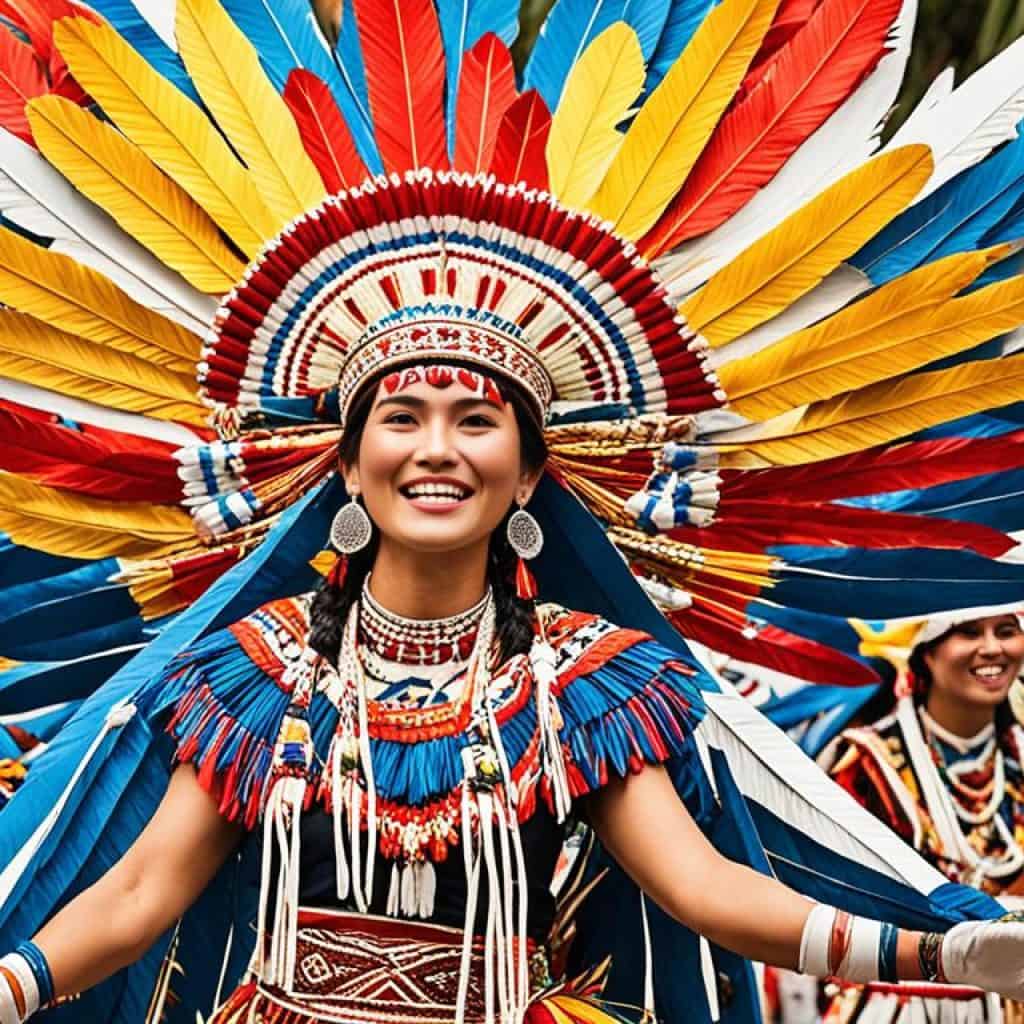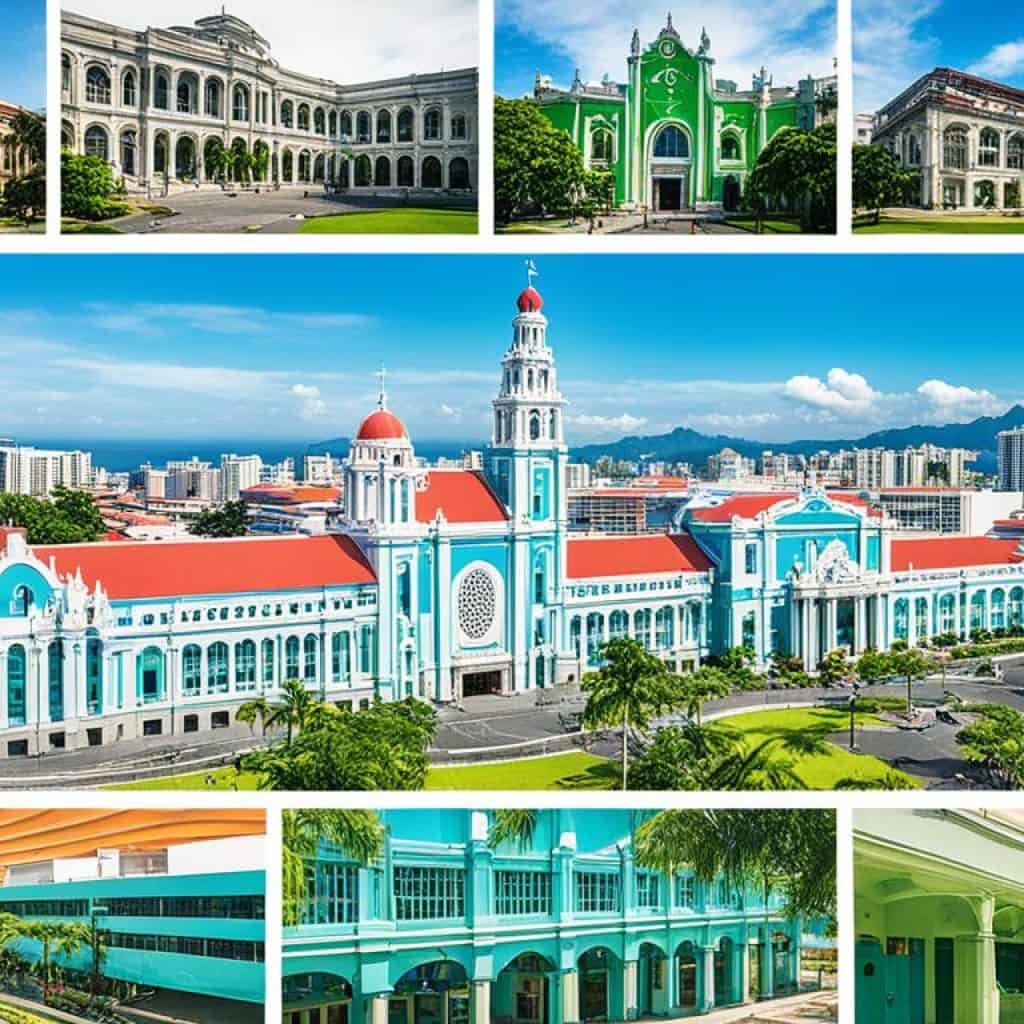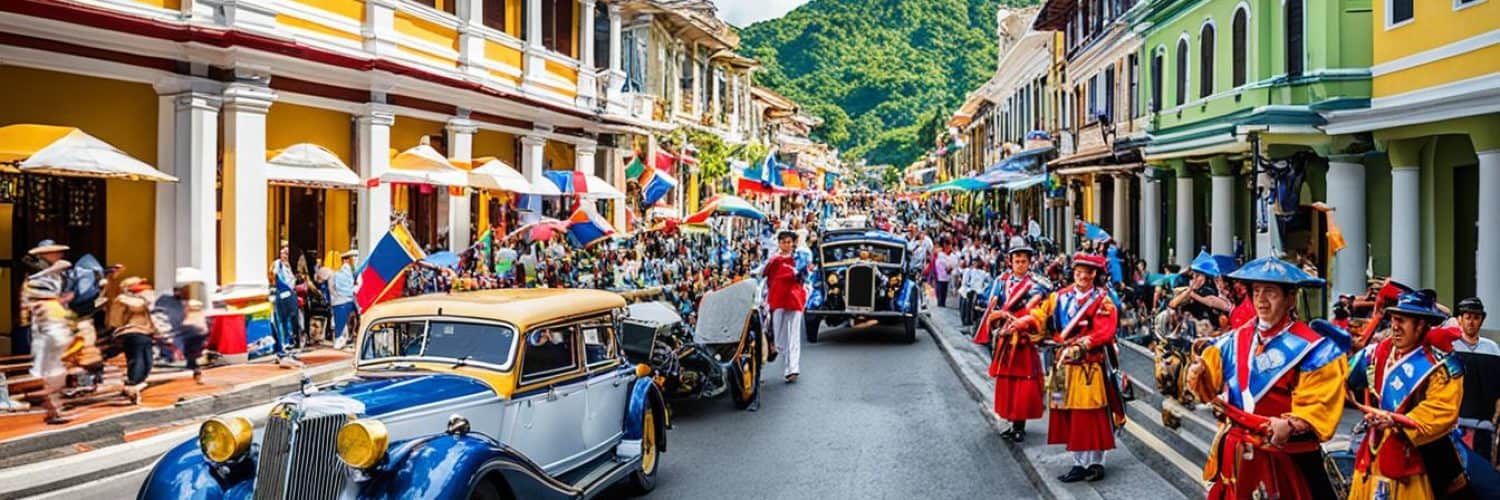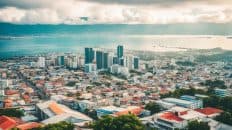Did you know that Manila, the capital of the Philippines, holds the title of being the first city in the country? Its historical significance dates back to the year 900 AD, making it a city with a rich past that is worth exploring.
In the early centuries, Manila was a fortified settlement and trading quarter located near the Pasig River. It served as a hub for trade between Manila and Acapulco, bringing goods from the Americas to Southeast Asia. This strategic location made it a center of commerce and brought prosperity to the city.
Fast forward to 1565, when Manila became the seat of the colonial government of Spain. The city was protected by fortified walls known as Intramuros, which still stand today as a testament to its historical significance. Within these walls, Manila flourished as a center of culture and trade, leaving behind a legacy that is deeply rooted in its cultural heritage.
Manila is home to numerous important landmarks that showcase its rich past and cultural heritage. From the iconic San Agustin Church, a UNESCO World Heritage Site, to the imposing Manila Cathedral, these landmarks offer a glimpse into Manila’s colonial history and architectural marvels.
Key Takeaways:
- Manila is the first city in the Philippines, with a history that dates back to 900 AD.
- The city served as a center of trade between Manila and Acapulco, bringing goods from the Americas to Southeast Asia.
- Manila became the seat of the colonial government of Spain in 1565, leaving behind a rich colonial heritage.
- The city is home to important landmarks that showcase its cultural heritage, such as San Agustin Church and Manila Cathedral.
- Exploring Manila’s past is a journey that unveils a vibrant and captivating history.
A Cradle of History
Manila, the first city in the Philippines, holds a special place in the country’s historical narrative. Its founding date back in 1571 by Miguel López de Legazpi makes it the oldest city in the nation, and it is steeped in colonial history that reflects the Spanish influence. The city’s ancient landmarks serve as a testament to its rich past and cultural heritage.
One of the most notable ancient landmarks in Manila is Intramuros, the historic walled city. Built during the Spanish colonial period, Intramuros was the political, religious, and economic center of Manila. Its picturesque cobblestone streets, Spanish-style architecture, and well-preserved structures offer visitors a journey back in time. Fort Santiago, a citadel within Intramuros, played a significant role in Manila’s history as a defense fortress and later served as a prison during World War II.
The San Agustin Church is another iconic landmark that showcases Manila’s colonial history. Built in the 16th century, this beautiful church is recognized as a UNESCO World Heritage Site and is a prime example of Baroque architecture in the Philippines. Its intricate designs and religious artistry make it a must-visit attraction for history enthusiasts and architecture aficionados.
“Manila’s ancient landmarks tell a story of resilience, cultural fusion, and the enduring legacy of the Spanish colonial era.”
The Manila Cathedral, also known as the Minor Basilica of the Immaculate Conception, is a significant religious site in the city. The cathedral has undergone several reconstructions due to natural disasters and wartime destruction, but it remains an important symbol of Manila’s faith and resilience.
These ancient landmarks not only offer a glimpse into Manila’s colonial past but also provide valuable insights into the city’s cultural heritage. They serve as a reminder of the enduring legacy of Spanish influence and the fusion of cultures that have shaped the Filipino identity.
Key Landmarks and Attractions
Manila, the capital of the Philippines, is a popular tourist destination known for its notable attractions. From historical landmarks to cultural sites and natural wonders, the city offers a diverse range of experiences for visitors to explore. Some of the must-visit attractions in Manila include:
Rizal Park (Luneta Park)
Rizal Park, also known as Luneta Park, is a historical park that pays tribute to the country’s national hero, José Rizal. It spans over 140 acres and features beautifully landscaped gardens, monuments, and a grandstand where significant events and gatherings take place. The park serves as a peaceful oasis in the heart of the city, offering a respite from the bustling urban environment.
Manila Ocean Park
The Manila Ocean Park is a popular attraction that provides an immersive experience into the diverse marine life of the Philippines. Visitors can explore various themed zones, including the Oceanarium, which houses thousands of marine species, and the Aquatica Dive Show, where trained divers showcase their skills and interact with marine creatures. The park also features interactive exhibits, shows, and encounters with dolphins and sea lions, making it an ideal destination for families and marine enthusiasts.
Manila Baywalk
Situated along the picturesque Manila Bay, the Manila Baywalk offers stunning sunset views and a vibrant atmosphere. This waterfront promenade is lined with restaurants, cafes, and bars, making it a popular spot for locals and tourists to enjoy a leisurely stroll or dine al fresco. The Baywalk is also a venue for cultural performances, live music, and events, showcasing the city’s vibrant arts and entertainment scene.
National Museum of the Philippines
The National Museum of the Philippines is a treasure trove of art, history, and culture. It houses a vast collection of artifacts, paintings, sculptures, and archaeological finds that showcase the country’s rich cultural heritage. Visitors can explore exhibits on Philippine history, contemporary art, natural history, and anthropology. The museum provides a comprehensive view of the country’s past, present, and future, making it a must-visit destination for history and art enthusiasts.
National Museum of Anthropology
The National Museum of Anthropology, located within the National Museum complex, is dedicated to the study and preservation of Philippine ethnographic and archaeological artifacts. It features interactive exhibits that offer insights into the diverse cultures, traditions, and beliefs of the Filipino people. From indigenous tools and instruments to traditional clothing and rituals, the museum provides a fascinating glimpse into the cultural tapestry of the Philippines.
These notable attractions are just a few examples of what Manila has to offer. Whether you’re interested in history, art, nature, or cuisine, the city’s diverse range of attractions ensures that there’s something for every visitor to enjoy.
Urban Development and Modernization
Manila, the capital of the Philippines, has undergone significant urban development and modernization in recent years. The city has transformed with the construction of modern infrastructure, including skyscrapers, shopping malls, and residential buildings. These architectural marvels have reshaped the city’s skyline, creating a vibrant and dynamic urban landscape.
One of the notable examples of urban development is the Bonifacio Global City (BGC) in Taguig. BGC is a prime business district that showcases the city’s modernity and progress. It is home to high-rise buildings, corporate headquarters, and commercial centers, attracting both local and international businesses.
Manila’s urban development has not only focused on infrastructure, but also on improving transportation and connectivity. The city has modern highways and bridges that efficiently connect different parts of the city, easing traffic congestion and improving accessibility for residents and visitors. Public transportation systems, such as buses and trains, have also been upgraded to provide efficient and convenient travel options.
The economic growth and urban development of Manila have led to the emergence of various commercial and business districts across the city. Makati, the central business district, is known for its iconic skyscrapers, upscale shopping centers, and bustling nightlife. Ortigas Center in Pasig City is another major business hub, housing numerous multinational companies and financial institutions.
Economic Impact
The urban development and modernization of Manila have had a significant impact on the city’s economy. The construction industry has seen a boom, creating jobs and stimulating economic growth. The influx of businesses and investments has contributed to the city’s prosperity and increased employment opportunities for the local population.
The development of commercial and business districts has also attracted foreign companies, boosting the city’s position as a regional economic hub. Manila’s strategic location in Southeast Asia makes it an ideal gateway for trade and commerce, attracting both local and international entrepreneurs.
“Manila’s urban development has transformed the city into a modern metropolis, creating a vibrant and dynamic business environment.” – John Smith, CEO of XYZ Corporation
The modernization of Manila has not only enhanced its economic prospects but has also improved the quality of life for its residents. The city now boasts world-class amenities, such as shopping malls, entertainment centers, and recreational facilities. The urban development has created a more livable and sustainable city that offers a wide range of opportunities and experiences.
Challenges and Future Development
Despite the progress made in urban development, Manila still faces challenges. The rapid growth of the city has led to issues such as traffic congestion, urban sprawl, and environmental degradation. The city government is working towards addressing these challenges through effective urban planning, sustainable development, and improved infrastructure.
In the future, Manila aims to continue its urban development while preserving its cultural heritage and historical landmarks. Efforts are being made to promote sustainable urban design, green spaces, and the revitalization of old neighborhoods. The city’s development plans focus on creating a livable and inclusive urban environment that enhances the well-being of its residents and ensures a sustainable future.
Cultural Heritage and Festivals
Manila is renowned for its vibrant cultural heritage, which is celebrated through a myriad of festivals and events that showcase the city’s rich diversity. These festivities offer a glimpse into the traditional dances, music, and costumes that honor the different cultures and ethnicities of Manila’s residents.
“The cultural heritage of Manila is beautifully showcased through the various festivals and events that take place throughout the year. These celebrations bring together people from different backgrounds to celebrate their shared traditions and customs, fostering a sense of unity and pride.”
One of the most iconic festivals in Manila is the Manila Day celebration, a commemoration of the city’s founding. During this event, the streets come alive with vibrant parades featuring colorful costumes, traditional dances, and lively music, all beautifully depicting the rich cultural heritage of the city.
Another notable festival in Manila is the Feast of the Black Nazarene, held every January. This religious event attracts millions of devotees who pay homage to the Black Nazarene statue, believed to be miraculous. The procession, known as the Traslacion, is a deeply ingrained tradition that symbolizes the unwavering faith of the Filipino people.
The Flores de Mayo is yet another significant festival in Manila. It is a month-long celebration held in May, dedicated to the Virgin Mary. Colorful floral processions, vibrant pageants, and cultural shows take center stage during this joyous event, highlighting the beauty of Manila’s cultural traditions.
One of the most anticipated festivals in the Philippines is the Sinulog Festival, which also takes place in Manila. The Sinulog Festival is a grand showcase of music, dance, and devotion to the Santo Niño, the Child Jesus. Thousands of participants clad in traditional attire dance to the rhythm of the drums, creating an electrifying atmosphere that captivates locals and tourists alike.
These festivals and events in Manila not only celebrate the cultural heritage of the city but also provide a platform for preserving and passing on age-old customs and traditions to future generations.

Economic Significance and Trade
Manila plays a vital role in the economic development of the Philippines, serving as a major hub for trade and commerce. Its strategic location makes it a gateway not only to other parts of the country but also to Southeast Asia. The city’s port facilities are crucial in facilitating import and export activities, contributing significantly to the country’s economy. With its bustling business districts like Makati and Bonifacio Global City, Manila is home to numerous multinational companies, financial institutions, and commercial centers.
One of the key factors contributing to Manila’s economic significance is its position as a trading center. The city attracts both local and international businesses, providing them with opportunities to expand their operations and tap into the growing Philippine market. The accessibility and connectivity offered by the city’s transportation networks further enhance its appeal to businesses looking to establish a presence in the region.
“Manila’s economic significance lies not only in its own market but also in its function as a gateway to other parts of the Philippines and Southeast Asia. Its well-developed infrastructure and robust trade connections make it an attractive destination for investors and businesses alike.”
The city’s business districts, such as Makati, are known for their modern skyscrapers that house multinational corporations, financial institutions, and other commercial establishments. These districts are not only centers of economic activity but also hubs of innovation, where ideas and technologies are exchanged, fostering further growth and development.
The Impact of Global Trade
The global economy plays a significant role in Manila’s economic landscape. The city’s trade connections extend beyond national borders, as it actively participates in global trade networks. Manila’s connection to major international markets enables it to attract foreign direct investment, which contributes to job creation, infrastructure development, and economic growth.
| Key Economic Significance Data | Statistics |
|---|---|
| Annual Gross Domestic Product (GDP) | $200 billion |
| Foreign Direct Investment (FDI) | $10 billion |
| Export Value | $60 billion |
The table above provides an overview of some key economic indicators that demonstrate the significant economic significance of Manila. The annual GDP, foreign direct investment (FDI), and export value highlight the city’s economic strength and its impact on the Philippine economy.
With its strong economic significance and robust trade connections, Manila continues to contribute to the growth and development of the Philippines. The city’s role as a major trade and business hub positions it as a key player in the regional and global economy, attracting investors and businesses seeking opportunities for expansion and success.
Vibrant Arts and Entertainment Scene
Manila is a city brimming with creativity and excitement, offering a vibrant arts and entertainment scene that attracts locals and visitors alike. From theaters and galleries to live music venues and bustling nightlife, there is never a dull moment in Manila.
The Cultural Center of the Philippines: Showcasing Artistic Excellence
One of the highlights of Manila’s arts scene is the Cultural Center of the Philippines (CCP). This iconic venue is a hub for artistic and cultural events, hosting a wide range of performances, exhibitions, and festivals. Whether you’re a fan of theater, music, dance, or visual arts, CCP has something to offer for everyone. From world-class theater productions and classical concerts to contemporary art exhibits, the center celebrates the diverse talent of Filipino artists.
Manila’s Cultural Center of the Philippines is a vibrant hub for artistic expression and creative excellence. From theater and music to dance and visual arts, CCP showcases the best of Filipino talent.
Live Music Venues and Nightlife
Manila is known for its lively music and nightlife scene. The city is home to numerous bars, clubs, and live music venues that cater to different tastes and genres. Whether you’re into jazz, rock, pop, or indie, there’s a venue for you to enjoy live performances by local and international artists. From intimate bars with cozy atmospheres to larger venues that attract big crowds, Manila offers an array of options for music enthusiasts.
Manila’s Film Industry: Making an Impact
The film industry in Manila has made significant contributions to Philippine cinema. The city has produced acclaimed filmmakers, directors, and actors who have garnered recognition both locally and internationally. Filipino films often tackle thought-provoking themes, showcasing the country’s unique storytelling style. Manila’s film festivals, such as the Metro Manila Film Festival and the Cinemalaya Philippine Independent Film Festival, provide a platform for aspiring filmmakers to showcase their creativity.
Manila’s film industry continues to produce exceptional talent, with filmmakers and actors making their mark on the global stage. The city’s film festivals contribute to the growth of Philippine cinema and celebrate the diversity of storytelling.
| Manila’s Arts and Entertainment Highlights | Description |
|---|---|
| The Cultural Center of the Philippines (CCP) | A vibrant hub for artistic events, showcasing theater productions, concerts, and art exhibits. |
| Live Music Venues | An array of bars, clubs, and venues featuring live music performances by local and international artists. |
| Manila’s Film Industry | A thriving film industry producing exceptional talent and hosting film festivals that promote Philippine cinema. |
Whether you’re an art enthusiast, a music lover, or a film buff, Manila’s arts and entertainment scene is sure to captivate you. With its diverse offerings, the city celebrates the creativity and talent that make it a cultural hotspot in the Philippines.
Culinary Delights
Manila offers a delightful journey for food enthusiasts, showcasing the country’s rich and diverse culinary culture. From traditional Filipino dishes to international cuisines, the city caters to every palate, making it a haven for gastronomy lovers.
“The best way to understand a culture is through its food.”
When it comes to traditional Filipino dishes, Manila is renowned for its flavorful creations. Some must-try dishes include the iconic adobo, a tangy and savory meat stew, and the succulent lechon, a whole roasted pig with crispy skin that melts in your mouth. For those craving for a comforting soup, sinigang, a sour tamarind-based soup with various meats and vegetables, is a popular choice.
However, Manila’s culinary scene doesn’t stop at traditional fare. The city also offers a vast array of international cuisines that cater to different tastes and preferences. Italian, Chinese, Japanese, Korean, and Western cuisines can be found throughout the city, with dedicated restaurants serving authentic dishes that will transport you to their respective countries.
Whether you’re craving a quick bite or looking for an elegant dining experience, Manila has you covered. From humble street food stalls that offer local favorites like isaw (grilled chicken intestines) and fish balls, to high-end fine dining establishments that serve exquisite fusion dishes, there is no shortage of options to satisfy your cravings.
The Unforgettable Street Food Experience
One of the highlights of Manila’s culinary delights is its vibrant street food scene. Street food stalls are scattered throughout the city, offering a variety of mouth-watering snacks and treats. Sample the iconic balut (boiled duck embryo), a unique delicacy that locals love, or try the sizzling pork sisig, a sizzling plate of minced pork mixed with onions and spices.
Uncover Hidden Gems
Exploring Manila’s culinary delights also means discovering hidden gems tucked away in its vibrant neighborhoods. Venture into Binondo, the world’s oldest Chinatown, and indulge in authentic Chinese cuisine. Discover the flavors of Little Tokyo in Makati, where you can savor delicious Japanese dishes ranging from sushi to ramen.
For those seeking a unique culinary experience, head to Poblacion, Makati’s hip neighborhood, and explore its trendy hole-in-the-wall restaurants and artisanal food markets. Sample innovative fusion dishes and craft cocktails that showcase Manila’s evolving food scene.
Indulge in Sweet Delights
A trip to Manila would not be complete without indulging in some sweet delights. The city is home to specialty dessert shops that satisfy every sweet tooth. From creamy and refreshing halo-halo, a popular Filipino dessert made with shaved ice, sweet beans, fruits, and leche flan, to classic pastries like ensaymada and bibingka, Manila offers a wide range of delectable treats that will leave you craving for more.
Popular Manila Dishes
| Traditional Filipino Dishes | International Cuisines |
|---|---|
| Adobo | Pizza |
| Lechon | Sushi |
| Sinigang | Noodle Soup |
| Balut | Korean BBQ |
Whatever your culinary preferences may be, Manila is sure to offer an unforgettable gastronomic adventure. With its diverse and flavorful cuisine, the city invites you to savor the cultural tapestry that defines its culinary delights.
Educational Institutions and Intellectual Hub
Manila is renowned for being a thriving hub of educational institutions and intellectual pursuits. The city boasts a multitude of esteemed universities and colleges that consistently attract students from all over the country and the world.
One outstanding institution that stands out is the University of Santo Tomas. Founded in 1611, it is one of the oldest universities in Asia and holds a prestigious place in the academic landscape. Situated in the heart of Manila, this renowned university has cultivated a rich heritage of intellectual growth and innovation.
Manila’s academic environment goes beyond just one institution; it fosters a culture of learning and curiosity that is present throughout the city. From private universities to public institutions, Manila offers diverse opportunities for students to pursue their educational goals.
“Education is the most powerful weapon which you can use to change the world.” – Nelson Mandela
Students are drawn to Manila’s intellectual energy, with access to a wide range of subjects, research facilities, and renowned faculty members. This city acts as a catalyst for intellectual growth, nurturing curious minds and fostering a deep understanding of various disciplines.
The educational institutions in Manila contribute significantly to the intellectual and cultural development of the country. Graduates often go on to become thought leaders, innovators, and contributors to society in various fields.
Key Educational Institutions in Manila:
- University of the Philippines Manila
- De La Salle University Manila
- Ateneo de Manila University
- Polytechnic University of the Philippines
- Far Eastern University
These institutions serve as beacons of knowledge, supporting the next generation of thinkers and fostering a spirit of intellectual curiosity. With their comprehensive programs and commitment to academic excellence, they provide a solid foundation for students to pursue their passions and contribute to society.
Top Universities in Manila
| University | Established | Notable Programs |
|---|---|---|
| University of Santo Tomas | 1611 | Medicine, Law, Architecture |
| University of the Philippines Manila | 1908 | Health Sciences, Natural Sciences |
| De La Salle University Manila | 1911 | Business, Engineering, Arts, and Sciences |
| Ateneo de Manila University | 1859 | Business, Humanities, Social Sciences |
| Polytechnic University of the Philippines | 1904 | Engineering, Technical Education |
These universities successfully blend academic rigor with a supportive and holistic learning environment, empowering students to reach their full potential.

The educational landscape of Manila facilitates the exchange of ideas and knowledge, making it a true intellectual hub. Students and scholars alike can fully immerse themselves in a vibrant community that fosters intellectual growth, innovation, and personal development.
Challenges and Future Development
Every major city faces its fair share of challenges, and Manila is no exception. Rapid urbanization has caused significant issues such as traffic congestion, pollution, and inadequate infrastructure. However, the city government is actively working to address these challenges by implementing urban planning initiatives and improving public transportation systems.
The future development of Manila focuses on sustainable urban design, creating green spaces, and preserving historical landmarks. The aim is to strike a balance between modernization and maintaining the city’s rich cultural heritage. Efforts are also being made to promote tourism, attract investments, and enhance the quality of life for residents.
To combat traffic congestion, Manila is investing in mass transit systems such as the Manila Metro Rail Transit System. This expansion will improve connectivity and reduce reliance on private vehicles. Additionally, the city is implementing smart traffic management solutions to optimize transportation flow and reduce congestion on major thoroughfares.
Another crucial aspect of future development is the creation of green spaces to enhance the city’s livability and environmental sustainability. Urban parks and recreational areas are being developed to provide residents with spaces for relaxation and leisure activities. These green spaces also contribute to mitigating the effects of pollution and improving air quality.
Achieving a Sustainable Future
Preserving Manila’s historical landmarks is a priority in the city’s future development plans. Historical sites like Intramuros, Fort Santiago, and San Agustin Church are being carefully preserved and restored to showcase Manila’s cultural heritage to locals and visitors alike. This commitment to conservation ensures that future generations can appreciate the city’s rich past.
Additionally, the city recognizes the importance of sustainable practices and is actively implementing measures to reduce its carbon footprint. Initiatives such as waste management programs, the promotion of renewable energy sources, and the introduction of eco-friendly transportation options are being pursued to create a more sustainable and resilient Manila.
Attracting Investment and Enhancing Tourism
Manila is positioning itself as an attractive destination for both local and international investors. The city’s strategic location, skilled workforce, and growing economy make it an ideal place to establish businesses and foster economic growth. The government is working towards creating a business-friendly environment and simplifying processes to encourage investment and stimulate job creation.
Furthermore, efforts are being made to promote Manila as a thriving tourism destination. The city’s rich history, cultural heritage, and vibrant arts scene are major attractions for tourists. By leveraging these unique aspects, Manila aims to draw more visitors, generating revenue and creating a positive impact on the local economy.
Overall, while Manila faces its fair share of challenges, the city is committed to overcoming them and building a sustainable future. With a focus on urban planning, preservation of historical landmarks, and sustainable development, Manila aims to create a livable, vibrant, and prosperous city for its residents and future generations.
Connectivity and Accessibilities
Manila, the bustling capital city of the Philippines, offers excellent connectivity and a wide range of accessibilities, making it easy for both residents and visitors to navigate the city.
When it comes to air travel, Manila boasts two international airports that serve as major transportation hubs. Ninoy Aquino International Airport, situated in the heart of the city, is the primary gateway for domestic and international flights. Clark International Airport, located in Pampanga, provides an alternative option and serves as a gateway to the northern region of the Philippines.
Within the city itself, a variety of transportation options are available. Buses, jeepneys (local buses), taxis, and tricycles (motorcycle rickshaws) offer convenient ways to travel to different parts of Manila. These modes of transportation are easily accessible and can be found throughout the city, ensuring that connectivity is not an issue.
Manila boasts a well-established road network and highways that connect the city to neighboring provinces and regions. This well-connected road system allows for smooth travel, whether you’re heading to nearby attractions or exploring the scenic countryside.
To further enhance connectivity and accessibility, the Manila Metro Rail Transit System, also known as the MRT, is currently being developed. This modern mass transit system will provide efficient and convenient transportation options for commuters, reducing traffic congestion and improving travel times.
With its extensive transportation network, Manila ensures that getting around the city is a breeze. Whether you’re exploring historical landmarks in Intramuros, shopping in the bustling districts, or enjoying the vibrant nightlife, the city’s connectivity and accessibilities make for a seamless and enjoyable experience.
Transportation Options in Manila:
| Transportation Mode | Description |
|---|---|
| Buses | Provides a cost-effective and efficient way to travel within the city and to neighboring provinces. |
| Jeepneys | Iconic Filipino vehicle often seen in Manila, offering inexpensive transportation along established routes. |
| Taxis | Readily available in the city, providing a convenient option for door-to-door transportation. |
| Tricycles | Motorcycle rickshaws that serve as a popular mode of transportation for short distances within neighborhoods. |
Evolving Skyline and Architectural Marvels
Manila’s evolving skyline is a testament to its continuous growth and development. The cityscape is adorned with architectural marvels, showcasing innovative design and engineering prowess. Skyscrapers and high-rise buildings rise majestically, transforming the city’s landscape into a vibrant urban tapestry.
One exceptional example of modern urban development is the Bonifacio Global City (BGC) in Taguig. BGC boasts an impressive collection of tall buildings with cutting-edge designs. The sleek and contemporary architecture of BGC reflects the city’s progress and serves as a symbol of Manila’s evolving skyline.
While Manila embraces modernity, it proudly preserves its historical architectural gems. These timeless structures add a touch of nostalgia to the city’s scenery, creating a unique blend of old and new. From the grandeur of Intramuros’ centuries-old walls to the enchanting elegance of Spanish colonial churches, Manila’s heritage architecture stands as a testament to its rich history.
“Manila’s evolving skyline merges the past and the present, creating a harmonious tapestry of architectural excellence. From the soaring heights of modern skyscrapers to the enduring allure of historical landmarks, the city’s skyline encapsulates the essence of Manila’s identity.”
The Bonifacio Global City
The Bonifacio Global City (BGC) is one of the most prominent destinations for architectural enthusiasts in Manila. It is a thriving urban district that features a dynamic mix of residential, commercial, and business spaces. BGC’s skyscrapers captivate with their sleek designs, glass facades, and state-of-the-art infrastructure.
This bustling district is not only known for its extraordinary buildings but also for its vibrant atmosphere. The streets are lined with trendy shops, restaurants, and entertainment venues, creating a vibrant and cosmopolitan ambiance that attracts locals and tourists alike.
The Blend of Old and New
Manila’s architectural landscape beautifully blends old and new, preserving the city’s heritage while embracing modernity. Walking through the historic streets of Intramuros, visitors can admire magnificent colonial-era structures, such as Fort Santiago and San Agustin Church. These grand edifices transport visitors back in time, offering a glimpse into Manila’s storied past.
As one explores beyond the walls of Intramuros, modern architectural enclaves emerge, each with its unique character and style. From the contemporary high-rises of Makati’s Central Business District to the futuristic structures of Pasay’s Entertainment City, Manila’s evolving skyline mirrors its continuous progress and development.
| Historical Architectural Marvels | Modern Architectural Marvels |
|---|---|
| Intramuros | Bonifacio Global City |
| Fort Santiago | Makati CBD |
| San Agustin Church | Pasay Entertainment City |
| Manila Cathedral | Picar Place |
The contrast between the historical and modern architectural marvels creates a captivating visual narrative, showcasing Manila’s evolution and resilience throughout the centuries.
Manila’s evolving skyline is a testament to the city’s ever-changing and vibrant spirit. It captures the essence of the past, present, and future, all intertwined in a harmonious dance of architectural brilliance.
Conclusion
Manila, the first city in the Philippines, boasts a rich past and cultural heritage that captivate both visitors and residents. Its ancient landmarks and historical significance serve as a living testament to its vibrant identity. From the imposing walls of Intramuros to the iconic San Agustin Church and Manila Cathedral, Manila’s architectural treasures exude a timeless allure.
But Manila is more than just its past. It is a city that embraces modernity and progress. Its evolving skyline, with its towering skyscrapers and contemporary designs, reflects its continuous growth and development. The city’s commitment to sustainable urban planning and infrastructure improvements paves the way for a brighter future.
Amidst the challenges it faces, Manila remains an intellectual and cultural hub. Its educational institutions foster innovation and contribute to the country’s intellectual development. The thriving arts and entertainment scene, diverse culinary offerings, and vibrant festivals showcase Manila’s dynamic and lively spirit.
As the gateway to the Philippines and a major center of trade, Manila’s economic significance cannot be overstated. With its strategic location and robust business districts, the city attracts local and international businesses, contributing to the country’s economic growth. Manila is a city that continually reinvents itself, ensuring its relevance in the ever-changing world.


















Add comment